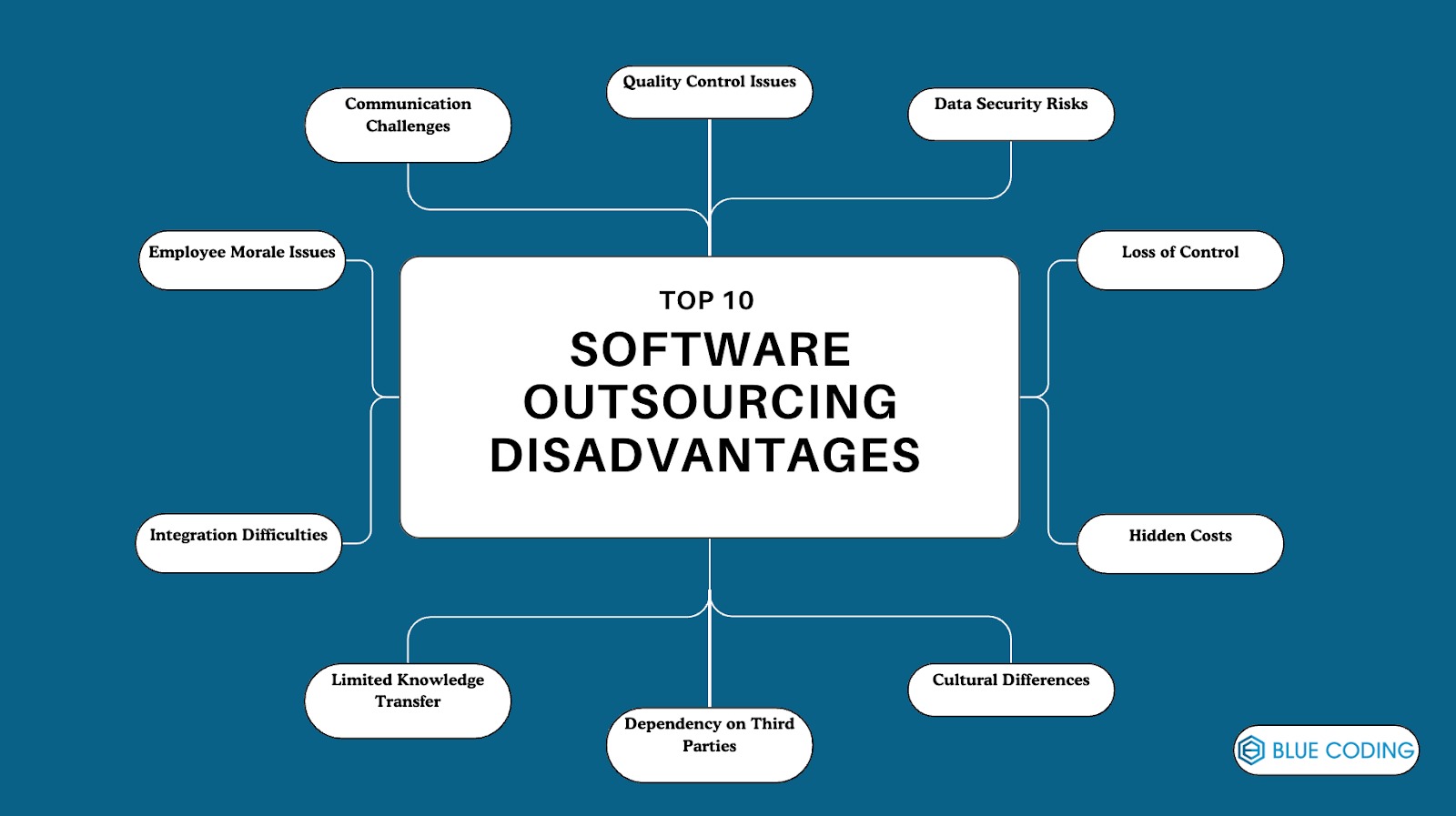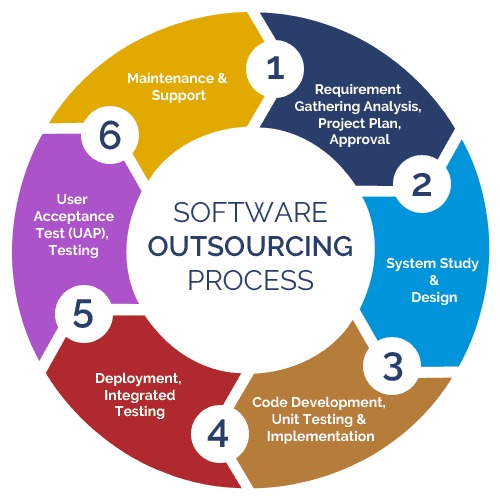 News
News
Every work-related task and milestone has its advantages and disadvantages. Whether you hire an in-house software development team or outsource all your software needs to remote development agencies, it is vital to be careful and aware of the entire process in order to avoid mishaps, scams, and technical issues. In this article, we discuss some of the potential software outsourcing benefits and software outsourcing disadvantages to help you make the right decisions for your business’ software needs.
Software Outsourcing Benefits - Top 10 Advantages in 2025
Cost Savings:
One of the most compelling reasons for businesses to consider software development outsourcing is cost savings. By leveraging outsourcing, companies can significantly reduce labor costs, especially when partnering with teams in countries with lower wages. This financial flexibility allows organizations to allocate resources to other essential areas, such as marketing or product development. As a result, businesses can maintain competitiveness without sacrificing quality.
Access to Global Talent:
In 2025, the tech industry continues to face a shortage of skilled professionals. Outsourcing opens the door to a diverse pool of talent from around the world. Companies can find experts with specific skills and experience that may not be readily available in their local markets. This access not only enhances the quality of work but also fosters innovation as different perspectives come together to solve problems.
Focus on Core Business Activities:
Outsourcing allows companies to concentrate on their core competencies. By choosing to opt for software development outsourcing, businesses can free up internal resources to focus on strategic initiatives. This shift enhances overall productivity and enables organizations to drive growth in areas where they excel. Ultimately, focusing on core activities leads to better business performance.
Faster Time to Market:
In today's fast-paced business environment, speed is crucial. Outsourcing can significantly accelerate the development process, allowing companies to bring products to market faster. External teams often have established processes and expertise that streamline development. By reducing time spent on recruitment and training, businesses can respond swiftly to market demands and gain a competitive edge.
Scalability and Flexibility:
Outsourcing provides businesses with the ability to scale operations up or down as needed. In 2025, market conditions may fluctuate rapidly, and companies must adapt accordingly. By partnering with an outsourcing provider, organizations can quickly adjust their development teams based on project requirements. This flexibility allows for efficient resource management without the long-term commitments associated with hiring full-time staff.
Enhanced Security and Risk Management:
As data security becomes increasingly critical, outsourcing can provide access to specialized knowledge and tools for managing risks. Reputable outsourcing firms often implement stringent security protocols and stay updated on industry best practices. By entrusting software development to these experts, companies can mitigate security risks, ensuring that sensitive information remains protected throughout the development process.
Improved Quality of Work:
Outsourcing allows companies to tap into specialized skills and knowledge that may not exist within their internal teams. By partnering with experts, businesses can improve the quality of their software products. Established outsourcing firms often employ best practices and the latest technologies, resulting in higher-quality output. This commitment to excellence ultimately leads to better user experiences and increased customer satisfaction.
24/7 Support and Development:
Outsourcing can enable round-the-clock development and support. With teams distributed across different time zones, businesses can ensure that work continues even when their in-house teams are offline. This advantage is particularly beneficial for companies looking to provide continuous support for their software products, enhancing customer satisfaction and reducing downtime.
Innovation through Collaboration:
Working with an external team can stimulate innovation. Outsourcing partners often bring diverse experiences and perspectives that can lead to fresh ideas and creative solutions. In 2025, businesses need to be innovative to stay relevant in the competitive landscape. This is something that companies considering software outsourcing need to know. Collaborating with talented professionals from various backgrounds fosters an environment where innovative ideas can thrive, ultimately benefiting the organization.
Long-term Partnerships:
Outsourcing is not just a transactional relationship; it can lead to long-term partnerships. Building strong connections with outsourcing providers can create a reliable support system for future projects. As businesses grow and evolve, having a trusted partner can simplify scaling operations and developing new software solutions. This collaborative approach can enhance overall efficiency and foster a sense of shared goals between organizations and their outsourcing partners.
Top 10 Software Outsourcing Disadvantages

While outsourcing software development offers potential benefits, the disadvantages in 2025 cannot be overlooked. Companies must weigh these factors carefully before deciding to outsource. Effective planning, strong communication strategies, and careful selection of partners can help mitigate some of these challenges, but it’s essential to understand that outsourcing is not a one-size-fits-all solution. By recognizing these disadvantages, companies can make more informed decisions that align with their long-term goals.
1. Communication Challenges
One of the most significant issues with outsourcing is the potential for communication barriers. Differences in language, culture, and time zones can lead to misunderstandings and delays. Effective communication is crucial in software development; when teams are not aligned, it can result in project setbacks and frustrations. Regular check-ins and updates may be necessary, consuming time and resources that could be better spent on development.
2. Quality Control Issues
When outsourcing, maintaining quality control can be difficult. The standards of work may vary significantly from one provider to another, leading to inconsistency in the final product. Companies often find that the software developed does not meet their expectations or the quality they hoped for, necessitating additional costs for revisions and corrections. Establishing clear quality benchmarks and conducting thorough testing becomes essential, but these steps can add time and complexity to the process.
3. Data Security Risks
Software development outsourcing can expose companies to data security risks. Sharing sensitive information with third-party providers increases the likelihood of data breaches or leaks. Even with contracts in place, the potential for compromised security remains a concern, particularly in an age where data protection regulations are becoming more stringent. Organizations must ensure that outsourced teams comply with relevant security standards and protocols, which can require additional oversight and management.
4. Loss of Control
Outsourcing often means relinquishing some control over the development process. Companies may struggle with oversight and may feel disconnected from the project as it progresses. This lack of control can lead to frustrations and a feeling of powerlessness, especially if the outsourced team does not follow the company’s vision. Regular updates and feedback loops are necessary to maintain alignment, which can be time-consuming and challenging to manage effectively.
5. Hidden Costs
While Software development outsourcing is often seen as a cost-saving measure, hidden costs can emerge throughout the project. These can include additional fees for revisions, extended timelines, and costs associated with managing remote teams. Companies may find that the initial savings do not outweigh these unexpected expenses, making it crucial to have a detailed contract that outlines all potential costs upfront. Failing to account for these hidden costs can lead to budget overruns and financial strain.
6. Cultural Differences
Cultural differences can significantly impact collaboration and teamwork. Different approaches to work, deadlines, and feedback can lead to tension and misunderstandings. Companies may struggle to create a cohesive working relationship, which is essential for successful project outcomes. Building cultural awareness and fostering respect among team members can help bridge these gaps, but it requires time and effort that may detract from project focus.
7. Dependency on Third Parties
Relying on an external provider creates a dependency that can be risky. If the outsourced team faces issues—such as financial instability, changes in business focus, or even political instability in their region—it can disrupt the project and affect the overall timeline. This dependency can be particularly concerning if the provider does not have a strong track record, leading to anxiety about the project's future and the quality of the outcomes.
8. Limited Knowledge Transfer
Outsourcing can lead to limited knowledge transfer between the outsourced team and the internal team. When the project is handed over to an external provider, the in-house team may not gain the skills or insights needed for future projects. This can hinder the organization’s ability to innovate and adapt in the long run. Companies may miss out on valuable learning opportunities that could strengthen their internal capabilities, resulting in a cycle of dependency on outsourcing.
9. Integration Difficulties
Integrating outsourced work with existing systems can be challenging. Different teams may use various tools, technologies, or methodologies that do not align well with the company's infrastructure. This can lead to additional work and complications, negating the benefits of outsourcing. Ensuring that the outsourced software is compatible with existing systems often requires additional time and resources, complicating the integration process.
10. Employee Morale Issues
Outsourcing can impact the morale of existing employees. When teams see work being sent outside the organization, it can lead to feelings of insecurity and decreased job satisfaction. Employees may worry about job stability, which can affect productivity and overall company culture. Maintaining open communication with staff about the reasons for outsourcing and how it impacts their roles is essential to mitigate these concerns and foster a more positive work environment.
Hire Remote Software Developers With Blue Coding
Working with remote individuals has its ups and downs but the mishaps can be eliminated if you collaborate only with a reliable and renowned agency that has been around for ages. We would therefore like to welcome you to consider us! At Blue Coding, our top priorities include customer satisfaction and high-quality services. We ensure that our programmers deliver the best and desired results without compromising on the quality and without compromising on the well-being of the developers. To learn more about how we can help your specific business, hop on a free strategy call with us!




